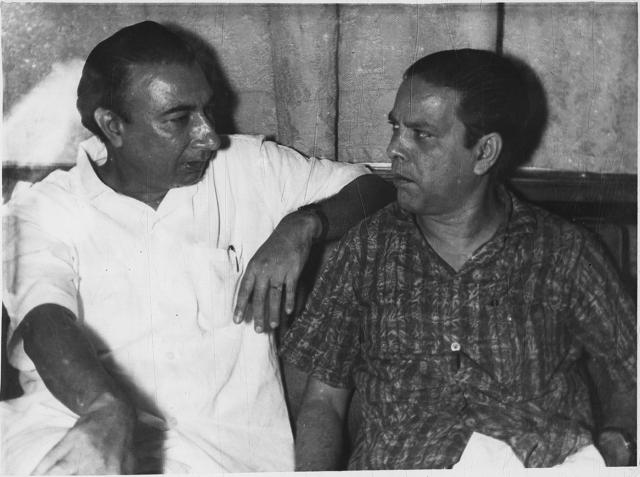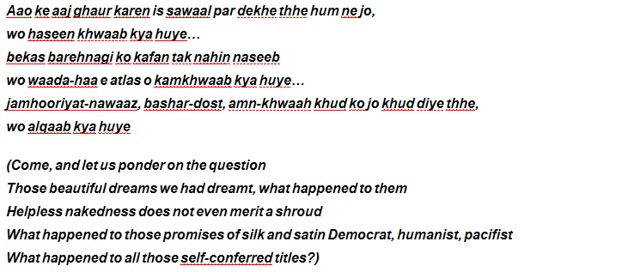Main Har Ek Pal Ka Shayer Hun: Remembering Sahir Ludhianvi
In the great poet’s death week, Rana Safvi looks back at his life and times, and his soul-stirring oeuvre.
Abdul Hai may have died on 25th October 1980, but the sahir or the magic of his poetry is immortal. There’s an eternal flame named Sahir Ludhianvi burning in the hearts of poetry lovers all over the world.

Abdul Hai was just 13 when his rich landowner father remarried and his mother divorced him and left her husband’s house. The young boy was pitchforked into a battle for custody and legitimacy. His father Fazal Din took his mother to court, alleging that Sahir was illegitimate. The Lahore High Court gave the custody of the boy to the mother after establishing his legitimacy. This led to a strong bond between the mother and son and took on the tones of a fixation, which harmed his later relationships too. Apart from the mental trauma Sahir endured at such a young age, after having spent his childhood in luxury, he was now consigned a life of penury.

They say that the ‘sweetest songs are those that sing of saddest thoughts’ and perhaps it was these early life experiences which gave the young boy the power to tap into the depths of pain that could move his readers.
His universal appeal lies in his ability to delve into every facet of human emotion – for he lived through most of them – and convert them into poetry. Most of his poems were later converted into lyrics for movies. He was one of the few lyricists who did not set a lyric to music but let it be set to his words.

This was immortalised into the hit 1975 song from the movie, Ek Mahal Ho Sapnon Ka.
Most of Sahir’s life is very well documented and we get a glimpse into the experiences which shaped it. He joined the Khalsa High School in Ludhiana and later the SC Dhawan Government College for Boys in the same city, but was soon expelled from there. The reasons are shrouded in conjecture but it is said that he was thrown out for sitting with a female classmate, said to be the college principal’s daughter, in the principal’s lawns.
In 1943, he moved to Lahore and joined the Dayal Singh College. He became active in student politics and was elected the president of the student federation. It was here that in 1945 he published his first book of poetry very appropriately called Talkhiyan (Bitterness).
Meanwhile, he joined the Progressive Writers Movement, which was effective in changing the contours of Urdu poetry. No longer was the emphasis on the Beloved, instead the focus shifted to Gham-e-Dauran (sorrows of the material world) as opposed to Gham-e-Jaanan (sorrows of the lover). The poets wrote on the oppression of the imperialists, capitalists and dictators.
Sahir was already in Lahore at the time of Partition and he stayed on. But his writings, especially one he wrote in favour of Pandit Nehru, soon led to a question of his survival in Pakistan. He fled to Delhi, where he struggled to find a foothold in the world of journalism and failed.
Finally he settled in Mumbai, then called Bombay. Since he hardly had any money, Sahir stayed in the house of writer Ismat Chughtai whom he knew. Ismat Chughtai’s husband was a filmmaker who Sahir hoped would help him find work in the film industry. But he was politely told that soul-stirring nazms on the struggle of people and film lyrics were a pole apart.
It was a chance meeting with SD Burman that got Sahir a break in the 1951 film Naujawan. For the film’s songs, he combined love, longing and allegories of nature to form a beautiful combination:
Thandi hawaaein lehra ke aayein, rut hai jawaan, tum ho yahan, kaise bhulayein
A mastery he showed again in Hamraaz (1967)
Neele gagan ke tale dharti ka pyaar pale
From then on, Sahir teamed up with SD Burman, an association which ended only when both felt Guru Dutt’s classic Pyaasa (1957), owed its success to them. As far as Sahir was concerned his lyrics were the hero of the film especially since the film was loosely based on Sahir’s own life and struggles. But S D Burman begged to differ and felt it was his great music that added to the film’s success. Be it whatever, their partnership broke up.
Sahir used his own verses in the film, tweaking a few words here and there to fit in with the music and created evergreen classics. If ever there was a movie, a classic in its own right but on which immortal poetry left its mark, it is Pyaasa. I doubt if there is anyone familiar with Hindi film music who – at one time or the other in their lives – has not hummed one of Pyaasa’s songs.
The fight between the material world and conscience is immortalized in
Yeh duniya agar mil bhi jaaye to kya hai
Or Jinhe naaz hai Hind par woh kahan hain
It’s these early setbacks and self doubts which reflected in a lot of his nazms. As Danish Iqbal, a playwright who has written two plays on Sahir Ludhianvi says, “He was himself in his nazms where he expressed the demons in his head. In his film lyrics, he was just the voice of the hero, detached from his own self.”
On the one hand he wrote:
Chuu lene do nazuk honton ko as the voice of Raj Kumar in Kaajal (1965)
But in real life, his romantic life was floundering. His first romantic liaison with the principal’s daughter had ended in tragedy. The young girl died and a distraught Sahir wrote a nazm named Marghat (place of cremation) at her funeral.
His later relationships all reflected this insecurity and fear of loss. He had an intense relationship with poet Amrita Pritam, but it could not lead to the happily ever after for them. By now he had also become an alcoholic and a chain smoker. In fact Amrita Pritam said on the record that she would save his half-smoked cigarette butts and smoke them later to feel closer to him.


Insecurity in love, commitment phobia has always existed, but more so today than before.
Jeevan ke safar mein rahi milte hain bichad jaane ko
Which youngster in love, won’t relate to Abhi naa jao chod kar?
A long relationship with singer Sudha Malhotra, too, met the same fate. Sahir was short-tempered and his mercurial temperament and mood swings prevented any relationship from lasting for long.
Sahir Ludhianvi led the charge in poetry and films, bringing out the frustrations of the post-independence generation whose dreams and aspirations were not being met.
Woh subah kabhi tau aayegi written as Umeed for the independence movement was used in the film Phir Subah Hogi (1958) as disillusionment started to set in.

He expressed the anguish of a nation, which had hoped for the dawn of a better life under a democratic government after years of colonial oppression. These lines found resonance then and will always remain popular as long as people feel their dreams are unrealized.
Not only was Sahir a people’s poet, he was also a rebel unafraid to take on the establishment.
His song from the same movie is a satirical take off on Iqbal’s Saare Jahan Se Achcha.
Chiin-o-arab hamaara hindostaann hamaara rehne ko ghar nahiin hai saara jahaan hamaara
(China and Arabia are ours Hindustan is ours We have no place to stay The whole world is ours)
This was a stinging indictment on the welfare policies as opposed to the grandiose propaganda of the government.
Some years later in a poem titled 26 January, written on Republic Day, Sahir lamented:

His communist philosophy also saw him challenge the symbol of love, the Taj Mahal in the nazm of same name. I remember growing up hearing it and still find it repeated often:

Notwithstanding his personal losses and disappointment, he became the voice of the youth by teaming up with O P Nayyar and giving cult songs to the nation.
Udde jab jab zulfein teri (Naya Daur, 1957)
Anyone who has been in love will testify to the romance in Kabhi kabhi mere dil mein (Kabhie Kabhie, 1976)
At a time when we see religious divide who does not want to sing the song from the 1959 film Dhool ka Phool?
Tu Hindu banega na Musalman banega, Insan ki aulad hai insan banega
With so much going on in his life, Sahir wrote inspiring verse after verse:
The naughty yet so philosophical Tadbeer se bigdi huyi taqdeer bana le
There is no end to Sahir’s magic and another very pertinent verse for today’s times is Jung aur Aman


In the movie Kabhie Kabhie, which starts with the song Main pal do pal ka shayer hun, the last scene shows the poet-hero played by Amitabh Bachchan singing the line Main har ek pal ka shayer hun.
Nothing describes Sahir Ludhianvi better.
Follow @htshowbiz for more
Get more updates from Bollywood, Taylor Swift, Hollywood, Music and Web Series along with Latest Entertainment News at Hindustan Times.
Get more updates from Bollywood, Taylor Swift, Hollywood, Music and Web Series along with Latest Entertainment News at Hindustan Times.





